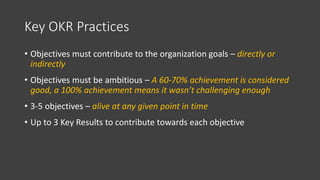Guide to OKR (Objectives & Key Results)
- 1. OKR A guide
- 2. What is OKR and what’s in it for me? • Is a management technique for recurring planning and progress reporting • Connects company, team and personal objectives to measurable results, making people move together in right direction • Helps keep vision, goals and objectives always in front of employees • Employees get clarity of knowing what’s expected from them
- 3. OKR stands for… • “Objectives” and “Key Results” • Is a management technique for recurring planning and progress reporting • Connects company, team and personal objectives to measurable results, making people move together in right direction
- 4. OKR Structure Objective Key Results … is Qualitative … are Quantitative Example: Build X skill within the team by Dec’ 14 Example: Arrange training on X Get team certified on X Do a POC to showcase capability on X • Planned and monitored continuously • Max 3 Key Results per Objective • 3-5 Objectives for a person at a time
- 5. So, Why OKR? • Simple to use • Helps keep vision, goals and objectives always in front of employees • People start moving towards goals, not small tasks • Employees get clarity of knowing what’s expected from them
- 6. Key OKR Practices • Objectives must contribute to the organization goals – directly or indirectly • Objectives must be ambitious – A 60-70% achievement is considered good, a 100% achievement means it wasn’t challenging enough • 3-5 objectives – alive at any given point in time • Up to 3 Key Results to contribute towards each objective
- 7. Implementation guidance • OKRs should be part of your role profile / day-to-day work – not outside of what you do but not routine also • Keep OKRs sizable – don’t slice them down to specifics • On-going OKRs – may not have KR end date, but should still be measurable • Growth focused – focus on building yourself, not completing the OKRs
- 8. …a few more • Ambitious – goals must be uncomfortable and hard to achieve • OKRs must be reviewed by managers periodically – usually every month or every quarter • Each OKR must be of a sizable duration – pick a duration that your company can comfortably measure • End date is important – keep it tagged on your desk • OKRs are live – do not type-in and forget
- 9. Our OKR tool… Our OKR tool built in-house @ Advaiya Solutions.
- 10. Thank you










